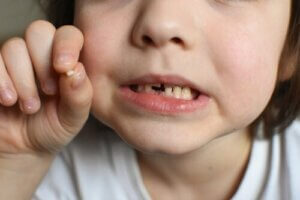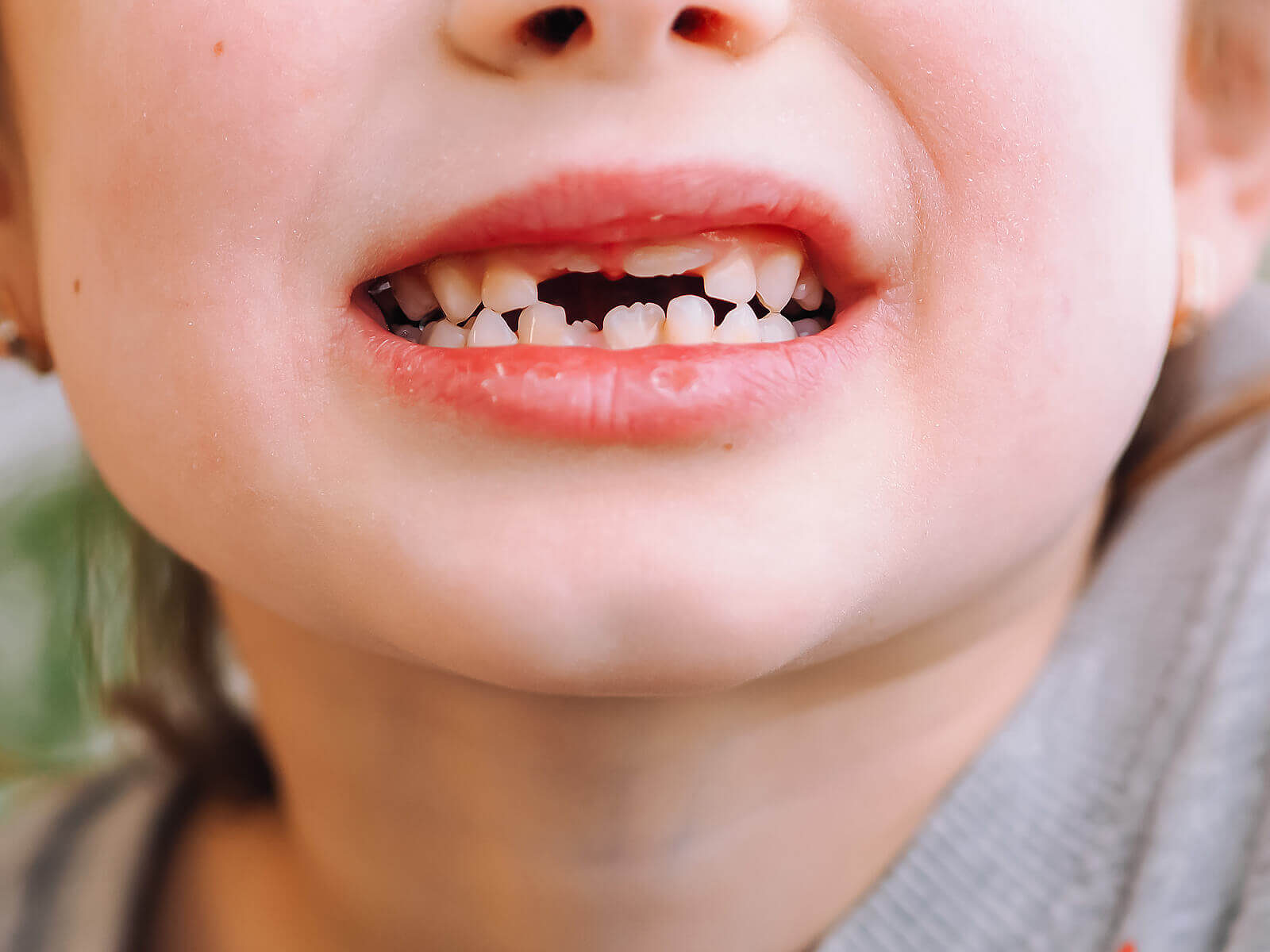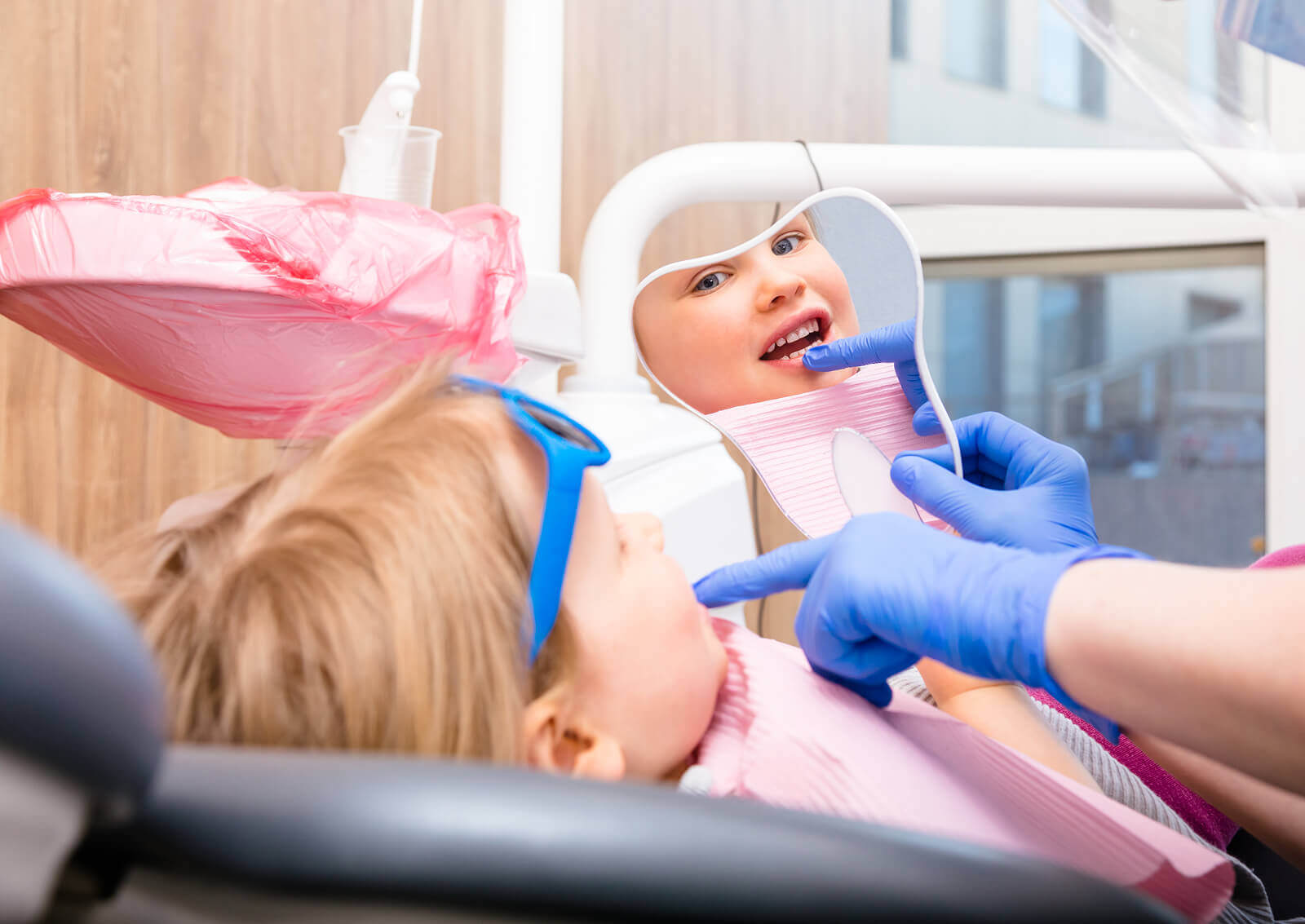Bumps to Baby Teeth: What to Do

Bumps to baby teeth occur quite frequently in children. That’s because there are various factors involved. In small infants, it often has to do with a lack of security and stability when walking. When it comes to older children, it’s often their own recklessness that makes them less careful and prone to bumps.
Bumps to baby teeth don’t have the same repercussions as bumps to permanent teeth. With this in mind, in the article below, we want to tell you what to do in the case that your child bumps their baby teeth.
What are baby teeth?
Baby teeth are those that appear during infancy. In general, they come in around a baby’s first birthday and aren’t permanent. Rather, they begin to fall out, on average, when children are seven or eight years old.

Baby teeth are very important during this stage because they play a key role in proper chewing and vocalizing. They also help children feel more confident when it comes to smiling and interacting with other people.
Therefore, maintaining good dental health and hygiene as well as regular dentist visits are essential during childhood.
You may also want to read: What Are the Symptoms of Teething in a Baby?
Bumps to baby teeth?
On the one hand, it’s common for babies to fall when they’re still learning to walk. Babies lack sufficient stability but, as they gain confidence, they may stop being careful and experience trips and falls. This stage often coincides with the appearance of baby teeth, so it’s an especially delicate time.
At the same time, children that are older – about six or seven – become more reckless. Their games tend to be faster and more careless. They run, climb, jump. And, of course, they’re no longer babies, meaning parental supervision isn’t as intense as it used to be. Therefore, during this stage, it’s common for children to experience bumps, accidents and falls that affect, among other things, their teeth.
The most frequent bumps to baby teeth occur when children are running or playing. Of course, they can also occur while participating in sports.
How to respond
There are many blood vessels throughout the entire mouth. For that reason, a bump to the teeth can cause them a lot of damage. What’s more, it can produce a lot of bleeding that, when mixed with saliva, makes bumps look much worse than they are.
Therefore, the first thing you should do when your child receives a bump is calm them down. Then, rinse their mouth gently in order to assess the true damage. At this point, there are several possible scenarios:
- All the teeth are in their place and are undamaged. In this case, you’ll carefully observe them over the next few days to make sure everything remains the same.
- Entire teeth may be missing. If this occurs in baby teeth, don’t try to put any fallen teeth back in their place. Doing so could damage the underlying roots of the permanent teeth that are still developing. In these cases, you’ll simply have to wait until the adult tooth comes in.
- Pieces of one or more teeth may have chipped off. If you find the missing pieces, you should wash them well and save them. That’s because, in some cases, dentists are able to reconstruct the tooth. To find out, take your child to the dentist, along with the tooth fragments, and allow the dentist to assess the situation.
- All of the teeth are in place, but one of several of them are wiggly. If this occurs, you’ll need to see a dentist in order to determine the severity and whether or not the bump has affected your child’s bite.

Upon inspecting the mouth, if you discover any of the above points, you should take your child to the dentist. That way, the professional can conduct a more exhaustive evaluation of your little one’s mouth and teeth
Proper care following bumps to baby teeth
In the days following the event, your child may complain of pain and discomfort in the mouth, depending on severity. So, you’ll need to make sure they continue practicing proper oral hygiene, but more carefully in case of increased sensitivity. You can also help by giving your little one softer foods that require less effort to chew – at least for a few days.
What’s more, if the bump was hard, your dentist may even recommend painkillers or even antibiotics for a few days. These will help reduce pain and prevent possible infections.
Don’t miss: When Should Children Start Brushing Their Teeth?
What you need to know about bumps to baby teeth…
Bumps to baby teeth are very common, especially during the first year and later on when children because more daring during play. Fortunately, most of the time, the damage isn’t severe and the consequences are minimal.
As always, it’s important to act quickly and efficiently. And, of course, in the case of any sign of alarm, you should see a dentist. He or she will be the one to make a proper diagnosis and recommend the right treatment.
Bumps to baby teeth occur quite frequently in children. That’s because there are various factors involved. In small infants, it often has to do with a lack of security and stability when walking. When it comes to older children, it’s often their own recklessness that makes them less careful and prone to bumps.
Bumps to baby teeth don’t have the same repercussions as bumps to permanent teeth. With this in mind, in the article below, we want to tell you what to do in the case that your child bumps their baby teeth.
What are baby teeth?
Baby teeth are those that appear during infancy. In general, they come in around a baby’s first birthday and aren’t permanent. Rather, they begin to fall out, on average, when children are seven or eight years old.

Baby teeth are very important during this stage because they play a key role in proper chewing and vocalizing. They also help children feel more confident when it comes to smiling and interacting with other people.
Therefore, maintaining good dental health and hygiene as well as regular dentist visits are essential during childhood.
You may also want to read: What Are the Symptoms of Teething in a Baby?
Bumps to baby teeth?
On the one hand, it’s common for babies to fall when they’re still learning to walk. Babies lack sufficient stability but, as they gain confidence, they may stop being careful and experience trips and falls. This stage often coincides with the appearance of baby teeth, so it’s an especially delicate time.
At the same time, children that are older – about six or seven – become more reckless. Their games tend to be faster and more careless. They run, climb, jump. And, of course, they’re no longer babies, meaning parental supervision isn’t as intense as it used to be. Therefore, during this stage, it’s common for children to experience bumps, accidents and falls that affect, among other things, their teeth.
The most frequent bumps to baby teeth occur when children are running or playing. Of course, they can also occur while participating in sports.
How to respond
There are many blood vessels throughout the entire mouth. For that reason, a bump to the teeth can cause them a lot of damage. What’s more, it can produce a lot of bleeding that, when mixed with saliva, makes bumps look much worse than they are.
Therefore, the first thing you should do when your child receives a bump is calm them down. Then, rinse their mouth gently in order to assess the true damage. At this point, there are several possible scenarios:
- All the teeth are in their place and are undamaged. In this case, you’ll carefully observe them over the next few days to make sure everything remains the same.
- Entire teeth may be missing. If this occurs in baby teeth, don’t try to put any fallen teeth back in their place. Doing so could damage the underlying roots of the permanent teeth that are still developing. In these cases, you’ll simply have to wait until the adult tooth comes in.
- Pieces of one or more teeth may have chipped off. If you find the missing pieces, you should wash them well and save them. That’s because, in some cases, dentists are able to reconstruct the tooth. To find out, take your child to the dentist, along with the tooth fragments, and allow the dentist to assess the situation.
- All of the teeth are in place, but one of several of them are wiggly. If this occurs, you’ll need to see a dentist in order to determine the severity and whether or not the bump has affected your child’s bite.

Upon inspecting the mouth, if you discover any of the above points, you should take your child to the dentist. That way, the professional can conduct a more exhaustive evaluation of your little one’s mouth and teeth
Proper care following bumps to baby teeth
In the days following the event, your child may complain of pain and discomfort in the mouth, depending on severity. So, you’ll need to make sure they continue practicing proper oral hygiene, but more carefully in case of increased sensitivity. You can also help by giving your little one softer foods that require less effort to chew – at least for a few days.
What’s more, if the bump was hard, your dentist may even recommend painkillers or even antibiotics for a few days. These will help reduce pain and prevent possible infections.
Don’t miss: When Should Children Start Brushing Their Teeth?
What you need to know about bumps to baby teeth…
Bumps to baby teeth are very common, especially during the first year and later on when children because more daring during play. Fortunately, most of the time, the damage isn’t severe and the consequences are minimal.
As always, it’s important to act quickly and efficiently. And, of course, in the case of any sign of alarm, you should see a dentist. He or she will be the one to make a proper diagnosis and recommend the right treatment.
All cited sources were thoroughly reviewed by our team to ensure their quality, reliability, currency, and validity. The bibliography of this article was considered reliable and of academic or scientific accuracy.
- Casals González, Y., Mirta, I. ;, Montero, E., Castillo, D., & González, G. (2011). Prevalence of sequelae of temporal teeth traumata in institutionalized children from the Playa municipality. In Revista Cubana de Estomatología (Vol. 48, Issue 1). http://scielo.sld.cu14
- Prevalencia y etiología de los traumatismos dentales: Una revisión. (n.d.). Retrieved July 10, 2020, from http://scielo.isciii.es/scielo.php?script=sci_arttext&pid=S1138-123X2003000200002
- Ávila Rivera, C., Cueto Urbina, A., & González Ríos, J. (2012). Caracterización del Traumatismo Dentoalveolar que Afecta a los Tejidos de Soporte en Dientes Temporales. International Journal of Odontostomatology, 6(2), 157–161. https://doi.org/10.4067/s0718-381×2012000200007
This text is provided for informational purposes only and does not replace consultation with a professional. If in doubt, consult your specialist.








